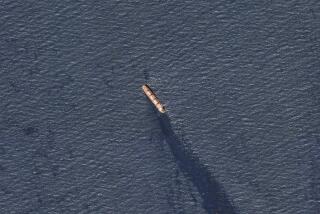Spill Threatens Saudi Oil Output : Production: A major processing facility will shut down if crude enters its water intakes. Miles of coastline and wildlife are also affected.
- Share via
MANAMA, Bahrain — A huge oil slick pushed down the Persian Gulf on Wednesday, coming ashore at a key Saudi oil installation, jeopardizing its production capability and threatening the country’s coastline and wildlife for miles.
U.S. Coast Guard officials said the oil, part of the largest spill in history, had moved about 3 1/2 miles during the night, reaching Tanajib, a service facility for Saudi Arabia’s giant oil company, Aramco.
The Coast Guard said the oil slick stretched from Safaniyah, 11 miles north of Tanajib, and was nearly 18 miles wide in the north and nine miles wide in the south. An oil sheen, visible from the air but containing less petroleum, stretched from near Safaniyah to Khafji, 40 miles to the north.
Most of this oil is believed to have leaked from storage tanks in Khafji, which were hit by Iraqi artillery fire at the start of the Gulf War. In addition, Iraqi forces released millions of barrels of oil into the sea off Kuwait, a spill that was mixing with the Khafji leak.
An Aramco official, who asked that he not be quoted by name, said Safaniyah was “all full of oil” and he predicted that Tanajib would look the same way in three days.
Safaniyah is the world’s largest offshore oil field, and the town onshore processes the oil from the offshore platforms. Segundo Fernandez, operating superintendent of the desalination plant in Tanajib, said Aramco will have to stop processing crude oil in Safaniyah if the spilled oil enters the processing facility’s water intakes.
However, an Aramco spokesman, Joseph Kenny, said that the offshore field remained in full operation.
Fernandez said that if oil seeped into the desalination plants either in Safaniyah or Tanajib, “it would basically shut down the water plant because it would foul their filtering system.”
Aramco has been deploying miles of flotation booms outside the water intakes to keep the spilled oil away, using 250 Indian workers hired to help deploy the booms.
“There’s oil outside the barriers,” said Abraham Joy, one of the Indian workers at the Tanajib facility Wednesday.
Crews were working around the clock to deploy more equipment at Safaniyah and Tanajib, according to Ali Mohssen, who is heading Aramco’s cleanup effort.
“There is still a chance of more oil because of weather,” Mohssen said. “We know with the weather--we have no control over it. We will get oil around us, but we try to minimize the impact on the shoreline (and) on the water intakes.”
He added that skimmer boats were offshore trying to recover the oil “before it hits us.”
A Norwegian oil cleanup ship hired by Aramco has collected more than 1.7 million gallons of oil and water mixture in the last week, according to U.S. Coast Guard officials in Dhahran. It collected 390,000 gallons on Tuesday alone.
At the capital of Riyadh, the head of Saudi Arabia’s committee for wildlife conservation and preservation, Abdul Aziz Abo Zenada, painted a bleak picture of the oil impact on wildlife, telling a news conference that “reports from the field indicate heavy losses in wildlife species.”
In one site inspected, Abo Zenada said, 50 birds were found dead and 400 others were fouled by oil but alive. Species most affected were black-necked grebes and rare Socotra cormorants, he said.
Abo Zenada conceded that the government had put its main emphasis on protecting people instead of wildlife, which meant that all of the protection equipment, such as flotation booms, had been diverted to industrial plants and water desalination sites, leaving none for wildlife areas.
Delegations of wildlife rescue workers were due to arrive in Saudi Arabia to help try to clean birds that have been affected by oil. As part of that effort, they are bringing tiny sweaters, which they hope will keep the birds warm and at the same time force oil to flow from their feathers.
Flotation booms arrived from Japan on Tuesday night, and more men and equipment from Norway arrived Wednesday. A second Japanese flight was due today.
This report was partially compiled from pool reports reviewed by military censors.
More to Read
Sign up for Essential California
The most important California stories and recommendations in your inbox every morning.
You may occasionally receive promotional content from the Los Angeles Times.













